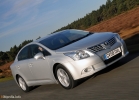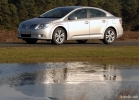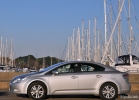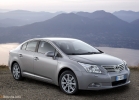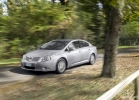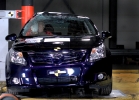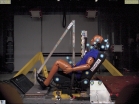Driver and passengers. Common score 32 | 90%
Frosting (15 points)

Driver |

Passenger |
 | - | Fine |
 | - | Good |
 | - | Satisfactorily |
 | - | Badly |
 | - | Very bad |
|
|
| Head |
| Driver's Head Contact with Airbag | Stable |
| Passenger's head contact with airbag | Stable |
| Breast |
| Passenger branch | Stable |
| Displacement front rack back | 27 mm. |
| Shift steering wheel back | No |
| Shift steering wheel up | No |
| Chest contact with steering wheel | No |
| Top of legs, knees and hip area |
| Contact with firm elements of the front panel | Yes |
| Knees | Yes |
| Lower leg and foot |
| Foot recess compression | No |
| Displacement pedals back | No |
| Pedal shift top | No |
|
Side collision with car (8 points), and with post (6 points)
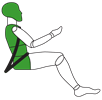
Automobile |
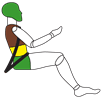
Pillar |
|
| Head Airbag | There is |
| Breast Airbag | There is |
|
Blow from behind (spinal protection) (points)
|
|
| Description of the chair | |
| Type of head restraint | Active |
| Geometric assessment | 1 |
| Test |
| - Strong kick | 2.7 |
| - Middle Stick | 2.3 |
| - Weak strike | 2.2 |
|
Children's passengers. Common score 42 | 86%
| Child up to 18 months |
| Brand chair | Britax Romer Duo Plus | Front shock |
| Emergency Group | 1 | Head move forward | Protected |
| Location | Face forward | Scald acceleration | Moderate |
| Fastening | ISOFIX and safety strap | Chest load | Insignificant |
| Side strike |
 | Evaluation of protection | 10 | Fixation of the head | Protected |
| Marking Evaluation | 4 | Scald acceleration | Moderate |
| Evaluation of fastening | 2 | |
| Child older than 3 years |
| Brand chair | Britax Romer Duo Plus | Front shock |
| Emergency Group | 1 | Head move forward | Protected |
| Location | Face forward | Scald acceleration | Moderate |
| Fastening | ISOFIX and safety strap | Chest load | Insignificant |
| Side strike |
 | Evaluation of protection | 12 | Fixation of the head | Protected |
| Marking Evaluation | 4 | Scald acceleration | Moderate |
| Evaluation of fastening | 2 | |
| Assessment of car | 5 | Airbag Prevention Warning | Warning sticker and Sunscreen visor pictogram |
Pedestrians. Common score 19 | 53% ACT system. Safety Common Score 6 | 86%

 - Fine - Fine
|
 - Good - Good
|
 - Satisfactory - Satisfactory
|
|
|
| Speed \u200b\u200blimiter | 0 (missing) |
| Stability Course (ESC) | 3 (in basic configuration option) |
| Signaling about unatigned safety belts | 3 (driver, front and felting passengers) |
| Head | 12.6 |
| Hip area. | 0.5 |
| Legs | 6 |
|
Protection of adult passengers:
With a frontal impact, the passenger salon was deformed slightly. Mannequin sensors noted good knee protection and hips of both front sedimons. The manufacturer managed to prove that the same level of protection is provided by passengers of various settings and in various positions. For the protection of all parts of the body, at the side of the side, the maximum number of points was put up, however, with lateral strikes, the load was unrealistic of the mannequin and the back of the chair, which could not happen to the human body in real conditions. For this removed several points. Protection against whip injuries when hit behind, it turned out to be good.
Security of passenger children
Based on the testimony of the sensors for the protection of a 3-year passenger, the car is awarded the highest rating. When estimating the safety of 1,5-year-old, several points were removed for using the chair set "in the direction of movement", although sensor readings indicate low loads. The front passenger airbag can be disabled, which allows you to install a children's chair "against the direction of movement" to this place. Pillows status reported clearly, which is very important for child safety or adult. In addition, the danger of placing the children's chair "against the direction of movement" opposite the active pillow also informs a clear warning.
Protection of pedestrians
The bumper provided pedestrian legs with good protection, like most places on the surface of the hood, where the child's head falls. However, an adult head is not provided as the "soft" blow.
Protection of pedestrians
The electronic stabilization system is available for all modifications of Avensis sold in Europe, and most copies are expected to be installed in the basic configuration. Also, the basic configuration includes an alarm for non-unspecified safety belts for both rows of seats.
General information about the car
| Tested model |
TOYOTA AVENSIS 2.0 D4-D, steering wheel on the right |
| Body type |
4-door sedan |
| Year of data publishing |
2009 |
| Curb weight, kg |
1531 |
Safety systems:
| Pretensels of front seat belts |
There is |
| Front Belts Load Loaders |
There is |
| Driver Front Airbag |
There is (single-stage) |
| Passenger Front Airbag |
There is (single-stage) |
| Side airbags |
There is |
| Side chest airbags |
There is |
| Airbag for knees and drivers |
There is |

